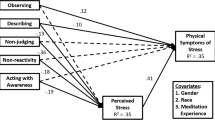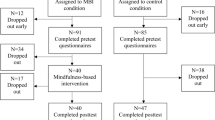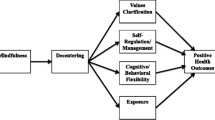Abstract
Although a growing body of research has demonstrated the benefits of mindfulness for depression and anxiety, the mechanisms by which mindfulness reduces emotional distress are unclear. At least two mechanisms have been proposed: reduced negative cognitive bias and stress reduction. Although both mechanisms have received initial support, these proposed mechanisms have not been examined concurrently. The present studies examined the extent to which less negative cognitive bias and less perceived stress uniquely accounted for the association between mindfulness and emotional distress. In two studies, participants completed measures of trait mindfulness, perceived stress, negative cognitive bias, depression, and anxiety. Across both studies, results from parallel multiple mediation models indicated that both negative cognitive bias and perceived stress accounted for unique variance in the mindfulness–emotional distress association. That is, greater mindfulness was related to less negative cognitive bias and less perceived stress, which in turn were associated with less emotional distress. The results suggest that both stress reduction and negative cognitive bias may be mechanisms by which mindfulness confers benefits to psychological well-being.


Similar content being viewed by others
References
Alloy, L. B., Abramson, L. Y., Whitehouse, W. G., Hogan, M. E., Panzarella, C., & Rose, D. T. (2006). Prospective incidence of first onsets and recurrences of depression in individuals at high and low cognitive risk for depression. Journal of Abnormal Psychology, 115, 145.
Arnett, J. J. (2008). The neglected 95%: Why American psychology needs to become less American. American Psychologist, 63, 602.
Baer, R. A. (2003). Mindfulness training as a clinical intervention: A conceptual and empirical review. Clinical Psychology: Science and Practice, 10, 125–143.
Baer, R. A., Carmody, J., & Hunsinger, M. (2012). Weekly change in mindfulness and perceived stress in a mindfulness-based stress reduction program. Journal of Clinical Psychology, 68, 755–765.
Beck, A. T. (1987). Cognitive models of depression. Journal of Cognitive Psychotherapy, 1, 5–37.
Beck, A. T., Epstein, N., Brown, G., & Steer, R. A. (1988). An inventory for measuring clinical anxiety: Psychometric properties. Journal of Consulting and Clinical Psychology, 56, 893–897.
Beck, A. T., Steer, R. A., & Brown, G. K. (1996). Manual for the Beck Depression Inventory-II. San Antonio: Psychological Corporation.
Beevers, C. G., Strong, D. R., Meyer, B., Pilkonis, P. A., & Miller, I. W. (2007). Efficiently assessing negative cognition in depression: An item response theory analysis of the dysfunctional attitude scale. Psychological Assessment, 19, 199–209.
Bergin, A. J., & Pakenham, K. I. (2016). The stress-buffering role of mindfulness in the relationship between perceived stress and psychological adjustment. Mindfulness, 7, 928–939.
Bishop, S. R. (2002). What do we really know about mindfulness-based stress reduction? Psychosomatic Medicine, 64(1), 71–83.
Bishop, S. R., Lau, M., Shapiro, S., Carlson, L., Anderson, N. D., Carmody, J., ... & Devins, G. (2004). Mindfulness: A proposed operational definition. Clinical Psychology: Science and Practice, 11, 230–241.
Brown, K. W., & Ryan, R. M. (2003). The benefits of being present: Mindfulness and its role in psychological well-being. Journal of Personality and Social Psychology, 84, 822–848.
Brown, K. W., Ryan, R. M., & Creswell, J. D. (2007). Mindfulness: Theoretical foundations and evidence for its salutary effects. Psychological Inquiry, 18, 211–237.
Brown, K. W., Weinstein, N., & Creswell, J. D. (2012). Trait mindfulness modulates neuroendocrine and affective responses to social evaluative threat. Psychoneuroendocrinology, 37, 2037–2041.
Chiesa, A., & Serretti, A. (2009). Mindfulness-based stress reduction for stress management in healthy people: A review and meta-analysis. The Journal of Alternative and Complementary Medicine, 15, 593–600.
Cohen, S., Kamarck, T., & Mermelstein, R. (1983). A global measure of perceived stress. Journal of Health and Social Behavior, 24, 385–396.
Creswell, J. D., & Lindsay, E. K. (2014). How does mindfulness training affect health? A mindfulness stress buffering account. Current Directions in Psychological Science, 23, 401–407.
Creswell, J. D., Pacilio, L. E., Lindsay, E. K., & Brown, K. W. (2014). Brief mindfulness meditation training alters psychological and neuroendocrine responses to social evaluative stress. Psychoneuroendocrinology, 44, 1–12.
Desrosiers, A., Vine, V., Klemanski, D. H., & Nolen-Hoeksema, S. (2013). Mindfulness and emotion regulation in depression and anxiety: Common and distinct mechanisms of action. Depression and Anxiety, 30, 654–661.
Doty, D. H., & Glick, W. H. (1998). Common methods bias: Does common methods variance really bias results? Organizational Research Methods, 1, 374–406.
Faul, F., Erdfelder, E., Buchner, A., & Lang, A.-G. (2009). Statistical power analyses using G*Power 3.1: Tests for correlation and regression analyses. Behavior Research Methods, 41, 1149–1160.
Feldman, G., Hayes, A., Kumar, S., Greeson, J., & Laurenceau, J. (2007). Mindfulness and emotion regulation: The development and initial validation of the Cognitive and Affective Mindfulness Scale–Revised (CAMS-R). Journal of Psychopathology and Behavioral Assessment, 29, 177–190.
Finlay-Jones, R., & Brown, G. W. (1981). Types of stressful life event and the onset of anxiety and depressive disorders. Psychological Medicine, 11, 803–815.
Frewen, P. A., Evans, E. M., Maraj, N., Dozois, D. J. A., & Partridge, K. (2008). Letting go: Mindfulness and negative automatic thinking. Cognitive Therapy and Research, 32, 758–774.
Fritz, M. S., & MacKinnon, D. P. (2007). Required sample size to detect the mediated effect. Psychological Science, 18, 233–239.
Gilbert, B. D., & Christopher, M. S. (2010). Mindfulness-based attention as a moderator of the relationship between depressive affect and negative cognitions. Cognitive Therapyand Research, 34, 514–521.
Gu, J., Strauss, C., Bond, R., & Cavanagh, K. (2015). How do mindfulness-based cognitive therapy and mindfulness-based stress reduction improve mental health and wellbeing? A systematic review and meta-analysis of mediation studies. Clinical Psychology Review, 37, 1–12.
Hayes, A. F. (2013). An introduction to mediation, moderation, and conditional process analysis: A regression-based approach. New York, NY: Guilford Press.
Hofmann, S. G., Sawyer, A. T., Witt, A. a., & Oh, D. (2010). The effect of mindfulness-based therapy on anxiety and depression: A meta-analytic review. Journal of Consulting and Clinical Psychology, 78, 169–183.
Hölzel, B. K., Carmody, J., Evans, K. C., Hoge, E. A., Dusek, J. A., Morgan, L., et al. (2009). Stress reduction correlates with structural changes in the amygdala. Social Cognitive and Affective Neuroscience, 5, 11–17.
Jarvis, B. G. (2010). MediaLab. New York: Empirisoft.
Kabat-Zinn, J. (1982). An outpatient program in behavioral medicine for chronic pain patients based on the practice of mindfulness meditation: Theoretical considerations and preliminary results. General Hospital Psychiatry, 4, 33–47.
Kabat-Zinn, J. (1994). Wherever you go, there you are: Mindfulness meditation in everyday life. New York: Hyperion.
Khoury, B., Sharma, M., Rush, S. E., & Fournier, C. (2015). Mindfulness-based stress reduction for healthy individuals: A meta-analysis. Journal of Psychosomatic Research, 78, 519 528.
Kiken, L. G., & Shook, N. J. (2012). Mindfulness and emotional distress: The role of negatively biased cognition. Personality and Individual Differences, 52, 329–333.
Kiken, L. G., & Shook, N. J. (2014). Does mindfulness attenuate thoughts emphasizing negativity, but not positivity? Journal of Research in Personality, 53, 22–30.
Lee, E. H. (2012). Review of the psychometric evidence of the perceived stress scale. Asian Nursing Research, 6, 121–127.
Metalsky, G. I., & Joiner, T. E. (1992). Vulnerability to depressive symptomatology: A prospective test of the diathesis-stress and causal mediation components of the hopelessness theory of depression. Journal of Personality and Social Psychology, 63, 667–675.
Nolen-Hoeksema, S., & Davis, C. G. (1999). “Thanks for sharing that”: Ruminators and their social support networks. Journal of Personality and Social Psychology, 77, 801.
Nolen-Hoeksema, S., Wisco, B. E., & Lyubomirsky, S. (2008). Rethinking rumination. Perspectives on Psychological Science, 3, 400–424.
Nyklíček, I., Mommersteeg, P., Van Beugen, S., Ramakers, C., & Van Boxtel, G. J. (2013). Mindfulness-based stress reduction and physiological activity during acute stress: A randomized controlled trial. Health Psychology, 32, 1110–1113.
Preacher, K. J., & Hayes, A. F. (2004). SPSS and SAS procedures for estimating indirect effects in simple mediation models. Behavior Research Methods, 36, 717–731.
Ramel, W., Goldin, P. R., Carmona, P. E., & Mcquaid, J. R. (2004). The effects of mindfulness meditation on cognitive processes and affect in patients with past depression. Cognitive Therapy and Research, 28, 433–455.
Riskind, J. H. (1997). Looming vulnerability to threat: A cognitive paradigm for anxiety. Behaviour Research and Therapy, 35, 685–702.
Riskind, J. H., & Williams, N. L. (1999). Specific cognitive content of anxiety and catastrophizing: Looming vulnerability and the looming maladaptive style. Journal of Cognitive Psychotherapy, 13, 41–54.
Riskind, J. H., Williams, N. L., Gessner, T. L., Chrosniak, L. D., & Cortina, J. M. (2000). The looming maladaptive style: Anxiety, danger, and schematic processing. Journal of Personality and Social Psychology, 79, 837–852.
Segal, Z. V., Williams, J. M. G., & Teasdale, J. D. (2002). Mindfulness-based cognitive therapy for depression: A new approach to relapse prevention. New York: Guilford.
Shapiro, S. L., Astin, J. A., Bishop, S. R., & Cordova, M. (2005). Mindfulness-based stress reduction for health care professionals: Results from a randomized trial. International Journal of Stress Management, 12, 164.
Shapiro, S. L., Carlson, L. E., Astin, J. A., & Freedman, B. (2006). Mechanisms of mindfulness. Journal of Clinical Psychology, 62(3), 373–386.
Shook, N. J., Ford, C. G., & Boggs, S. T. (2017). Dangerous worldview: A mediator of the relation between disgust sensitivity and social conservatism. Personality and Individual Differences, 119, 252–261.
Taren, A. A., Creswell, J. D., & Gianaros, P. J. (2013). Dispositional mindfulness co-varies with smaller amygdala and caudate volumes in community adults. PLoS One, 8, e64574.
Taren, A. A., Gianaros, P. J., Greco, C. M., Lindsay, E. K., Fairgrieve, A., Brown, K. W., … Creswell, J. D. (2014). Mindfulness meditation training alters stress-related amygdala resting state functional connectivity: A randomized controlled trial. Social Cognitive and Affective Neuroscience, 10, 1758–1768.
Treynor, W., Gonzalez, R., & Nolen-Hoeksema, S. (2003). Rumination reconsidered: A psychometric analysis. Cognitive Therapy and Research, 27, 247–259.
van der Velden, A. M., Kuyken, W., Wattar, U., Crane, C., Pallesen, K. J., Dahlgaard, J., … Piet, J. (2015). A systematic review of mechanisms of change in mindfulness-based cognitive therapy in the treatment of recurrent major depressive disorder. Clinical Psychology Review, 37, 26–39.
Vinchurkar, S. A., Singh, D., & Visweswaraiah, N. K. (2014). Self-reported measures of mindfulness in meditators and non-meditators: A cross-sectional study. International Journal of Yoga, 7, 142.
Vøllestad, J., Nielsen, M. B., & Nielsen, G. H. (2012). Mindfulness- and acceptance-based interventions for anxiety disorders: A systematic review and meta-analysis. British Journal of Clinical Psychology, 51, 239–260.
Way, B. M., Creswell, J. D., Eisenberger, N. I., & Lieberman, M. D. (2010). Dispositional mindfulness and depressive symptomatology: Correlations with limbic and self-referential neural activity during rest. Emotion, 10, 12–24.
Author information
Authors and Affiliations
Contributions
CGF designed and executed the study, conducted data analysis, and wrote the paper. NJ collaborated with the design and execution of the study, consulted on data analytic procedures, and collaborated with writing and editing the manuscript.
Corresponding author
Ethics declarations
All procedures performed in studies involving human participants were in accordance with the ethical standards of West Virginia University and/or national research committee and with the 1964 Helsinki declaration and its later amendments or comparable ethical standards.
Conflict of Interest
The authors declare that they have no conflict of interest.
Informed Consent Statement
Informed consent was obtained from all participants before participation.
Rights and permissions
About this article
Cite this article
Ford, C.G., Shook, N.J. Negative Cognitive Bias and Perceived Stress: Independent Mediators of the Relation Between Mindfulness and Emotional Distress. Mindfulness 10, 100–110 (2019). https://doi.org/10.1007/s12671-018-0955-7
Published:
Issue Date:
DOI: https://doi.org/10.1007/s12671-018-0955-7




